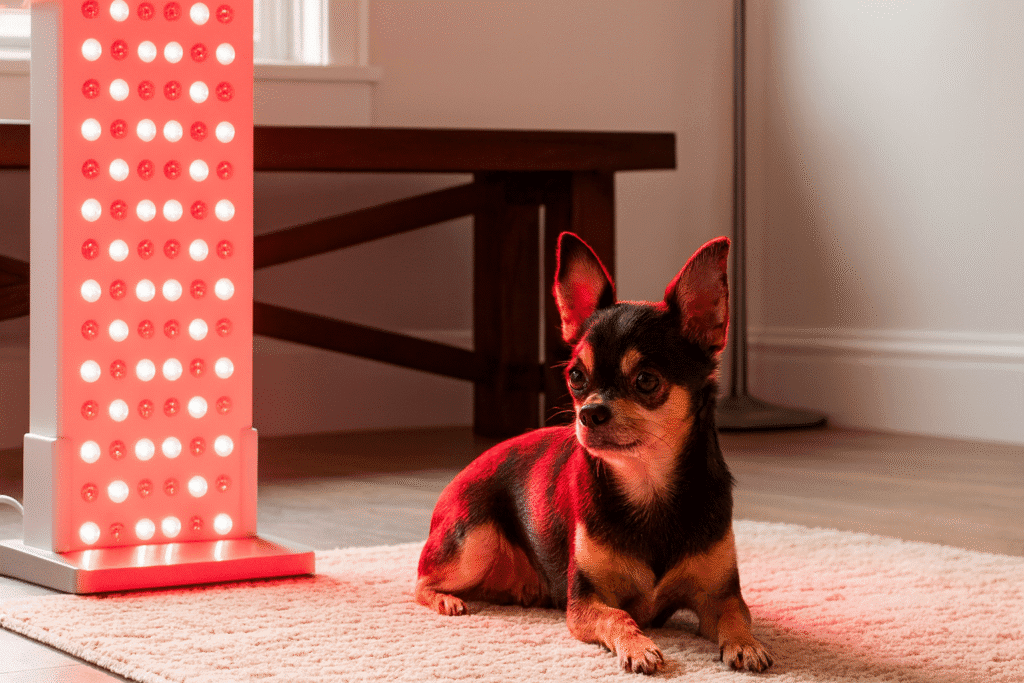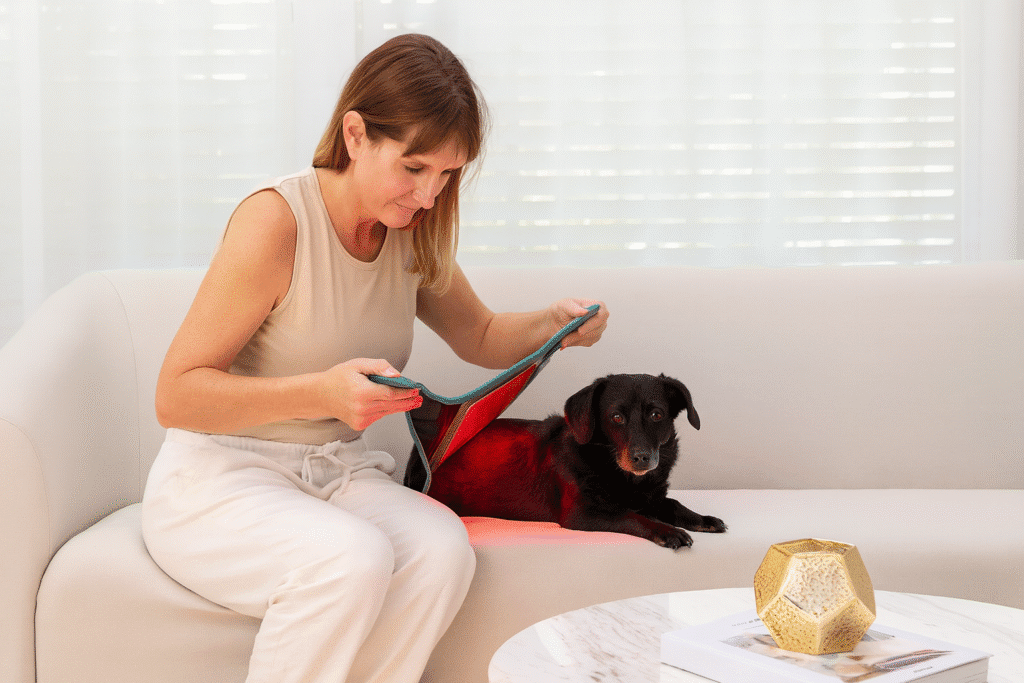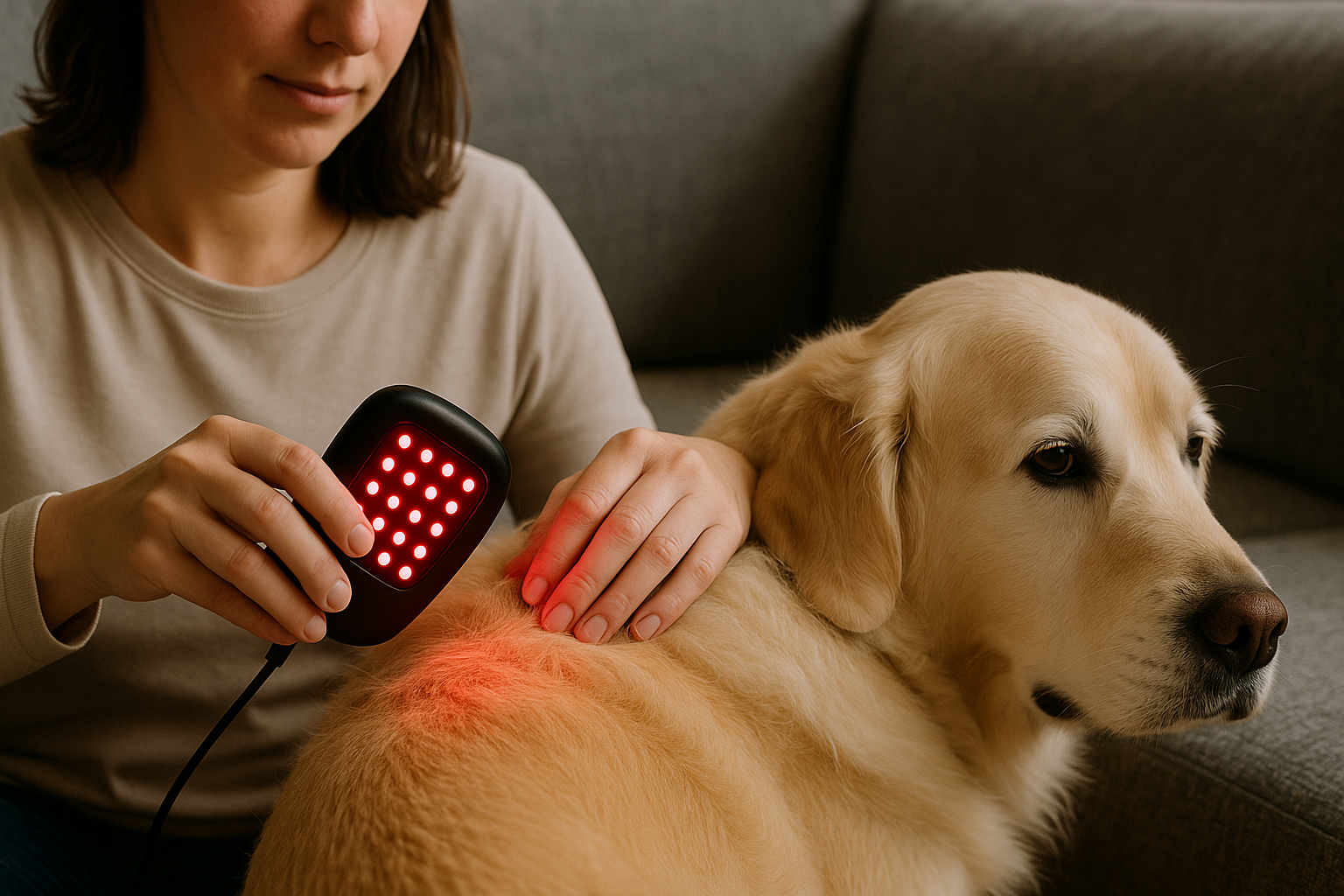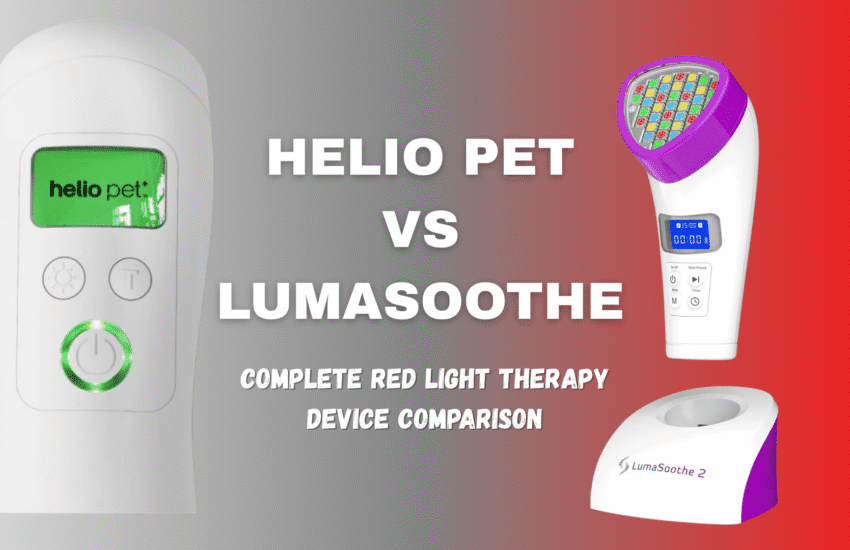Is Red Light Therapy Safe for Pets? A Guide for Dog and Cat Owners
If you’ve been researching treatment options for your pet’s arthritis or slow-healing wound, you’ve probably come across red light therapy. Veterinary clinics are increasingly offering this treatment, and home devices are flooding the market.
But what exactly is it, and more importantly, is it safe for your pet?
Understanding Red Light Therapy for Pets
Red light therapy, also known as photobiomodulation or low-level laser therapy, uses specific wavelengths of red and near-infrared light to stimulate cellular function and promote healing in animals.
The treatment aims to harness the power of light to enhance our pets’ health, much like how sunlight can boost our own mood and vitality.
The concept isn’t new. Medical professionals have used similar light-based treatments for decades in human medicine. Now, veterinarians are applying these same principles to help our four-legged patients.
The Science Behind Red Light Therapy Treatment

Wavelengths
Red light therapy typically uses wavelengths between 630-660 nanometers (nm) for red light and 810-850 nm for near-infrared light. These specific wavelengths are chosen for their ability to penetrate the skin and underlying tissues, reaching cells and stimulating biological processes.
Cellular Energy
The therapy works by interacting with the mitochondria in cells. When exposed to these specific light wavelengths, mitochondria are stimulated to produce more ATP (adenosine triphosphate), which is essentially cellular energy.
Photobiomodulation
This term refers to the use of light to cause biological changes at a cellular level. In red light therapy, these changes are generally positive and can lead to improved cellular function and assist with healing processes.
Safety Guidelines for Using Red Light Therapy on Your Pet
Red light therapy is generally safe for pets when used properly. Unlike some other forms of light therapy, red light doesn’t produce heat or cause burns, making it a gentle option for our animal companions.
However, there are important considerations to keep in mind:
- Use devices specifically designed for veterinary use or pet therapy. Human devices may be too strong or not calibrated correctly for animal use (pet-specific devices are calibrated with animal skin thickness and fur density in mind).
- Proper eye protection is essential, as direct exposure to intense light could potentially harm your pet’s eyes. Some clinics use protective goggles for pets during treatment, while others simply ensure the light isn’t directed at the face.
- Professional guidance is essential. A veterinarian should evaluate whether red light therapy is appropriate for your pet’s specific condition. Some health issues may contraindicate its use, and only a professional can make that determination.
Applications of Red Light Therapy for Pets
Red light therapy has shown promise in addressing a wide range of conditions in pets:
- Arthritis and joint pain
- Wound healing
- Skin issues
- Dental problems
- Neurological disorders
Because it’s so versatile, red light therapy can be a helpful option for pet owners seeking alternatives or add-ons to traditional care.
Implementing Red Light Therapy for Your Pet

If you and your veterinarian decide to try red light therapy, success often depends on proper implementation.
Start with a thorough veterinary consultation. Your vet needs to assess whether your pet is a good candidate for the therapy and rule out any conditions that might make treatment inappropriate. They can also help set realistic expectations—this isn’t a miracle cure, and some pets respond better than others.
Choosing the right device requires careful consideration. The market offers everything from handheld wands for targeted treatment to full-body beds for larger coverage areas.
Factors to consider include:
- The specific wavelengths offered (both red and near-infrared are ideal)
- Power output appropriate for your pet’s size
- Safety certifications and veterinary approval
- Ease of use and cleaning
- Your budget and commitment level
Most pets tolerate red light therapy well, but introducing it properly helps ensure success. Start with shorter sessions—perhaps just five minutes—and gradually work up to the recommended duration. Use positive reinforcement (such as treats and praise) to create pleasant associations with treatment time. Many pets learn to relax during sessions, and some even fall asleep.
Treatment protocols vary depending on the condition being addressed. Acute injuries might benefit from daily sessions, while chronic conditions often require treatments two to three times per week. Most treatments last between 5-10 minutes, depending on the condition and your pet’s size.
Consistency matters more than intensity. Short, regular sessions tend to be more effective than occasional, prolonged treatments. Keep a simple log of any changes in your pet’s condition or behavior—this can help your vet evaluate how well the therapy is working and adjust the plan if needed.
Realistic Expectations and Potential Challenges
While red light therapy can be incredibly useful, there are some potential issues to be aware of:
- Overuse of the therapy can potentially reduce its effectiveness, so it’s important to stick to recommended treatment protocols.
- Some pets may experience temporary redness or warmth at the treatment site, though this is usually mild and resolves quickly. If irritation persists or worsens, discontinue treatment and consult your veterinarian.
- The therapy doesn’t work for every pet or every condition. Factors like the severity of the condition, the pet’s overall health, and individual biological responses all play a role in determining effectiveness. Always follow professional veterinary advice.
- Cost is another consideration. Professional treatments can range from $50 to $150 per session, and most conditions require multiple sessions. Home devices usually have a larger upfront investment but may prove more economical for long-term treatment.
Adapting Red Light Therapy for Different Pets
One of the great things about red light therapy is its adaptability. For instance, if you’re treating a dog with arthritis, you might focus the therapy on their joints. For a cat with a skin condition, you could target specific areas of their coat.
This flexibility allows for tailored treatments that can address a wide range of conditions in various types of pets.
Red Light Therapy for Dogs: Size and Condition Matter
Large Dogs (50+ lbs)
- May need longer treatment times or multiple sessions to cover larger areas
- Hip dysplasia: Focus on hip joints for 10-15 minutes per side
- Back issues: Use therapy pads along the spine, moving in sections
Small Dogs (Under 25 lbs)
- Require lower intensity settings and shorter sessions (5-10 minutes)
- Joint issues: Target specific areas like knees or elbows
- Whole-body treatments possible with smaller devices
Red Light Therapy for Cats: Special Considerations
Cats often require a gentler approach:
- Start with shorter sessions (3-5 minutes) as cats can be more sensitive
- For skin conditions, part the fur to ensure light reaches the skin
- Many cats prefer lying on therapy mats rather than having devices held over them
- Consider treating during natural rest times when they’re already relaxed
Red Light Therapy for Other Pets
Rabbits and Small Mammals
- Use lowest intensity settings
- Focus on specific injury sites rather than full-body treatment
- Sessions typically 3-5 minutes
Birds
- Requires specialized veterinary guidance
- Very short exposure times (1-2 minutes)
- Keep device at greater distance from body
Working with Fur and Feathers
Thick-Coated Animals
- May need higher intensity settings or closer positioning
- Consider gently parting fur for better light penetration
- Some owners clip fur in treatment areas (consult vet first)
Dark vs. Light Coats
- Dark fur may absorb more light/heat—monitor temperature
- Light-colored coats may require slightly longer treatment times
- Always check skin temperature during treatment
Remember: These adaptations are general guidelines. Always work with your veterinarian to develop a specific treatment plan tailored to your pet’s individual needs, condition severity, and response to therapy.
Comparing Red Light Therapy to Traditional Treatments
Understanding how red light therapy fits into the broader treatment landscape helps pet owners make informed decisions.
Traditional pain medications like NSAIDs remain the gold standard for many conditions. They typically work faster than red light therapy and have extensive research backing their use. However, long-term use can stress the liver and kidneys, making alternative treatments attractive for chronic conditions.
Physical therapy addresses mobility issues through movement and strengthening exercises. Red light therapy can complement physical therapy by potentially reducing pain and inflammation, making movement easier.
Surgical interventions are sometimes necessary and can provide definitive solutions to certain problems. Red light therapy might help with post-surgical healing but isn’t a replacement for necessary procedures.
Acupuncture, another alternative therapy, works through different mechanisms but may complement red light therapy well. Some practitioners use both modalities together.
Choosing the Right Red Light Therapy Device for Your Pet
With the growing popularity of red light therapy for pets, many devices have entered the market. Choosing the right one can seem overwhelming, but here are some factors to consider:
Type of Device
- Handheld wands: These are versatile and allow for targeted treatment of specific areas. They’re great for smaller pets or for treating localized issues.
- Pads or mats: These are ideal for larger areas or for pets that can lie comfortably on them. They’re often used for treating back or hip issues.
- Full-body beds: These provide whole-body treatment and can be useful for larger dogs or for treating many areas simultaneously.
When selecting a device, look for models that offer both red (630-660nm) and near-infrared (810-850nm) wavelengths, appropriate power output (30-150 mW/cm²), and essential safety features like automatic shut-off timers.
The most expensive option isn’t always the best—consult your veterinarian for recommendations based on your pet’s specific needs and condition.
The Future of Red Light Therapy in Veterinary Medicine
As research in this field continues to grow, we’re likely to see even more applications and refinements of red light therapy in veterinary medicine. Some exciting areas of development include:
- Combination therapies: Researchers are exploring how red light therapy can be combined with other treatments for better effects.
- Targeted treatments: More precise application methods are being developed to target specific tissues or organs more effectively.
- Wearable devices: We may see the development of wearable red light therapy devices that pets can use for extended periods, even while moving around.
- Customized protocols: As we learn more about how different animals respond to the therapy, we may see more species-specific and condition-specific treatment protocols emerge.
- Integration with telemedicine: As veterinary telemedicine grows, we might see remote monitoring and adjustment of red light therapy treatments.
The potential of red light therapy in veterinary medicine is vast, and it’s an exciting field to watch as it continues to advance.
Should You Try Red Light Therapy for Your Pet? Key Factors to Consider
Red light therapy offers a low-risk treatment option for various pet health conditions. When used appropriately under veterinary supervision, it’s generally safe and well-tolerated. Whether it’s right for your pet depends on their specific condition, overall health, and your ability to commit to a treatment protocol.
Before starting any new treatment, have an honest conversation with your veterinarian about your pet’s condition, your expectations, and your resources. Red light therapy works best as part of a comprehensive treatment plan, not as a standalone solution.
The therapy’s gentle nature and good safety profile make it worth considering for pets who haven’t responded well to traditional treatments or whose owners prefer to minimize medication use. Just remember that while the red glow might look like magic, the real power lies in consistent, appropriate application guided by veterinary expertise.
Frequently Asked Questions about Red Light Therapy for Pets
What is red light therapy for dogs?
Red light therapy for dogs is a non-invasive treatment that uses specific wavelengths of red and near-infrared light to stimulate cellular function and promote healing. It’s used to treat various conditions including arthritis, skin issues, and wounds.
Can I use a human red light therapy device on my pet?
It’s not recommended to use human red light therapy devices on pets. Pet-specific devices are calibrated for animal use and are generally safer.
Always ask with your veterinarian before using any red light therapy device on your pet.
How often should I use red light therapy on my pet?
The frequency of red light therapy treatments depends on your pet’s specific condition and the device you’re using. Generally, treatments might be daily for acute conditions or 2-3 times a week for chronic issues.
Always follow your veterinarian’s recommendations.
Is red light therapy painful for pets?
Red light therapy is typically not painful for pets. Most animals find the treatment relaxing, and some even fall asleep during sessions.
However, if your pet shows signs of discomfort, stop the treatment and ask your vet.
How long does it take to see results from red light therapy in pets?
The time to see results can vary depending on the condition being treated and the person pet. Some pet owners report seeing improvements within a few sessions, while others might take several weeks to notice significant changes. Consistency in treatment is key.
Can red light therapy help with my dog’s arthritis?
Many pet owners and veterinarians have found red light therapy helpful in managing arthritis symptoms in dogs. It may help reduce inflammation, increase circulation, and reduce pain associated with arthritis.
Is red light therapy safe for cats?
Red light therapy is generally considered safe for cats when used properly. However, cats may be more sensitive to light treatments than dogs, so it’s crucial to follow veterinary guidance and use devices specifically designed for feline use.
Can red light therapy help heal my pet’s wounds?
Red light therapy has shown promise in promoting wound healing in pets. It may help stimulate collagen production, increase blood flow to the affected area, and reduce inflammation, all of which can contribute to faster healing.
Are there any side effects of red light therapy for pets?
When used correctly, red light therapy typically has few side effects. Some pets might experience temporary redness or warmth at the treatment site.
If you notice any unusual reactions, stop the treatment and ask your veterinarian.
How does red light therapy compare to laser therapy for pets?
While both therapies use light to promote healing, they work differently. Red light therapy uses lower energy levels and can cover larger areas, while laser therapy often uses higher energy and is more targeted. Your vet can advise which is more suitable for your pet’s condition.
Key Takeaways
- Red light therapy is generally safe for pets when used correctly.
- It can be used to treat a variety of conditions, from arthritis to skin issues.
- Always ask with a vet before starting red light therapy for your pet.
- Choose pet-specific devices and follow treatment protocols carefully.
- Monitor your pet’s progress and adjust treatment as needed.

